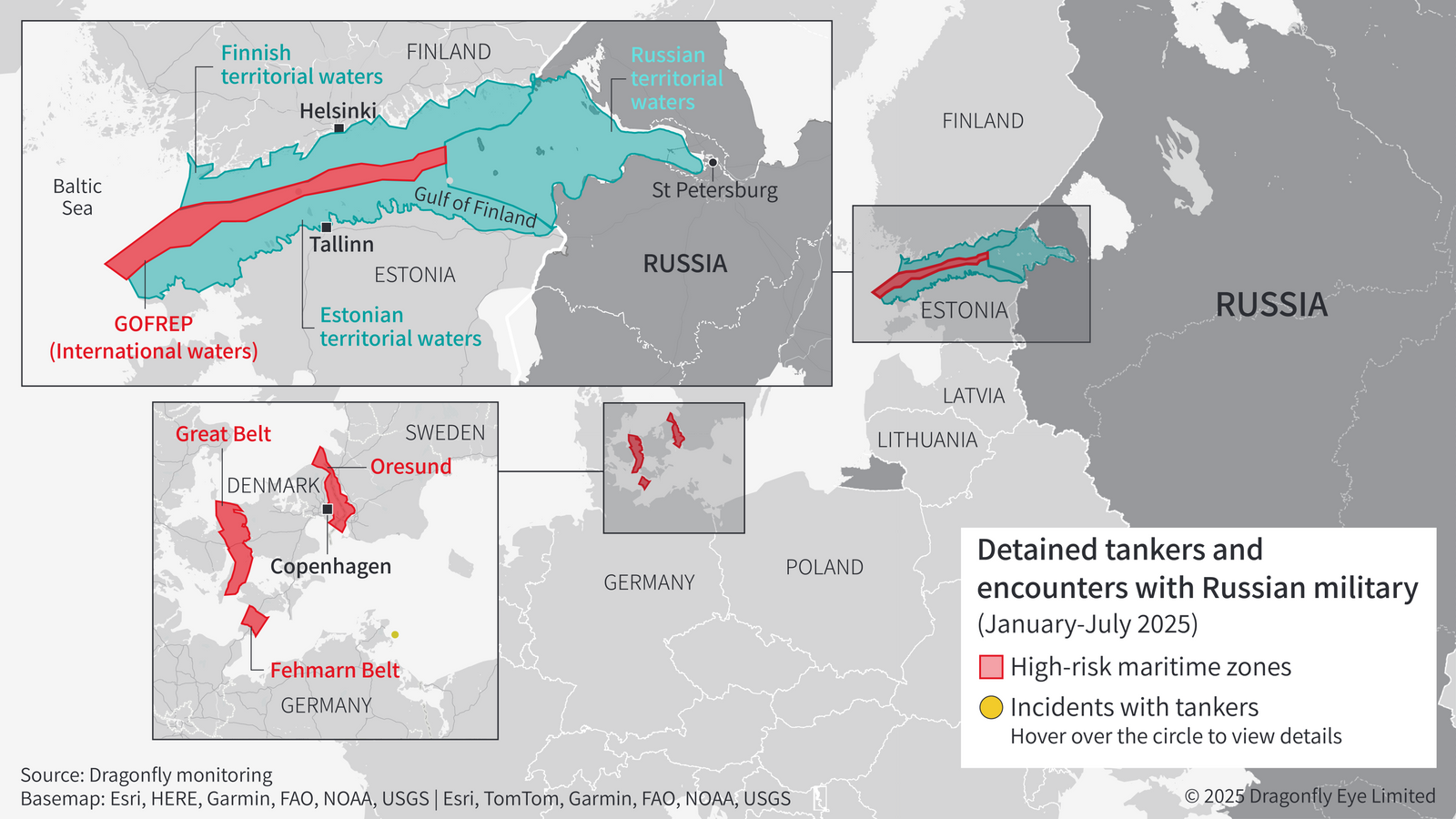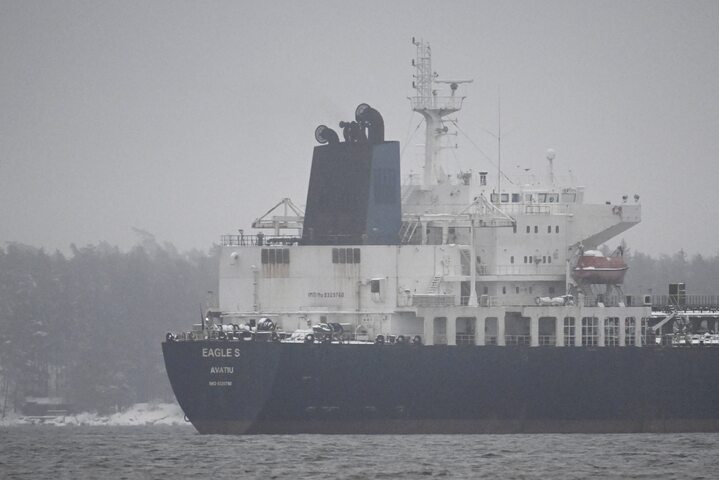
- Russia has seemingly started deploying military escorts for sanctioned oil tankers transiting European waters, particularly the Baltic Sea
- In late June, a Russian warship covertly escorted two sanctioned tankers through the English Channel and the Danish Straits
- Amid NATO efforts to police their waters, the moderate risk of a military standoff with NATO forces is likely to rise into 2026
Russia’s heightened military posture in the Baltic Sea is raising the moderate risk of confrontation with NATO. In recent months, Russia has started using its military to try to shield sanctions-evading energy shipments from scrutiny by European nations. This is particularly in the Gulf of Finland, the Danish Straits and the English Channel. A new EU sanctions package against Russia announced on 18 July is likely to incentivise Moscow to bolster its military presence in the Baltic Sea and beyond to secure its energy exports.
Russia appears determined to defend oil-exporting tankers
We do not know if Russia is now providing military escorts for all of its oil tankers traversing the Baltic Sea; there is no publicly-available information on this, as far as we are aware. So far, there has been just one confirmed case: a Russian warship in June accompanied two sanctioned tankers through the English Channel and Danish Straits using GPS spoofing to conceal its presence, according to various media outlets. But there have probably been others; the Finnish military said in May that Russia had ‘increased military presence in the Gulf of Finland to protect its maritime trade’.
European sanctions are prompting a heightened military posture from Moscow
Russia’s posture seems to largely be in response to European states bolstering their maritime security and enforcement of sanctions. Last month, the UK, German, Danish and Swedish governments announced that they would increase scrutiny of ships passing their territorial waters. Indeed, there have been at least two seizures and detentions of Russian-linked ships in the Baltic Sea this year (see infographic). There were no such cases in 2024, apart from Eagle S tanker, which was detained by the Finnish Coast Guard under suspicion of damaging undersea cables.
It is also clear that European efforts to limit Russian energy exports are driving Moscow to resort to such measures. Oil and gas sales are vital for Russia’s economy, accounting for around 30% of its federal budget revenues, and approximately 50% of Russia’s oil exports pass through the Baltic Sea. On 18 July, the EU agreed on its 18th package of restrictions, lowering the price cap from $60 to $47.6 per barrel of Moscow’s oil, as well as blacklisting over 100 vessels and intermediaries involved in sanctions circumvention.
Rising risk of Russian retaliation
There are two main risks that stem from this situation. First, Russia is likely to retaliate against attempted seizures of its vessels by arbitrarily detaining Western-flagged commercial ships crossing or close to its territorial waters. In a sign of this, on 18 May, Moscow detained for a day a Greek tanker leaving an Estonian port through Russian territorial waters. Following the incident, on 21 May, the Kremlin said that it will use ‘all means available’ to defend its energy exports and freedom of navigation.
Second is the risk of military confrontations between NATO forces and the Russian military vehicles escorting oil tankers. There have already been several incidents of Russian forces aggressively preventing their vessels from being inspected or detained: in the most recent such incident, on 13 May, Russian aircraft briefly violated Estonian airspace while its navy tried to detain a tanker (named Jaguar) sailing without a flag.
Based on the past incidents, other aggressive moves by Russia during military standoffs are likely to include:
- Warships firing warning projectiles at European navy vessels or aircraft; in November 2024, a Russian corvette shot a flare at a German navy helicopter on a patrol in the Baltic Sea
- Aircraft conducting low passes close to European forces; in June, Russian jets buzzed a US Navy ship during NATO exercises in the Baltic Sea
- Air defences locking on European vessels or nearby aircraft; in January and March, a French maritime patrol aircraft was locked on by Russian air defences in the Baltic Sea
- Ships attempting to ram other vessels; in 2018, a Ukrainian navy tug was reportedly rammed by a Russian warship
- Interference with nearby NATO aircraft; on at least two occasions (2023 and 2024), Russian fighter jets have damaged or shot down American surveillance drones over the Black Sea
Standoffs unlikely to lead to military escalation
We assess that any further confrontations between European and Russian forces would be very unlikely to lead to a war between Russia and NATO. In a sign that European navies are keen to de-escalate such encounters, they have been quick to stand down during previous incidents. During the incident with the Jaguar tanker in mid-May, the Estonian authorities attempted to detain the vessel, but instead escorted the ship to Russian territorial waters after a Russian jet violated its airspace.
Any incident during a military standoff around a Russia-affiliated tanker would instead be likely to prompt the affected country to seek consultations between NATO members (Article 4). This means that members would discuss how to respond to a potential threat.
Based on NATO’s current hesitancy to forcibly detain suspicious tankers, it seems likely that the bloc would respond by bolstering maritime security and operations further, rather than responding with direct military action. Nevertheless, our confidence in this assessment would fall were Moscow to shoot down a manned NATO aircraft or inflict casualties during any encounter at sea.
The Oil tanker Eagle S is seen anchored near the Kilpilahti port in Porvoo, on the Gulf of Finland on January 7, 2025. The Swedish navy said on January 7, it had recovered from the Baltic Sea the anchor of an oil tanker suspected of belonging to Russia’s ‘shadow fleet’ and damaging four underwater telecom cables and one power cable on December 25. The Eagle S, currently located east of Helsinki, is suspected of sabotage and Finnish authorities have banned eight crew from leaving Finnish territory. (Photo by Antti Aimo-Koivisto / Lehtikuva / AFP) / Finland OUT (Photo by ANTTI AIMO-KOIVISTO/Lehtikuva/AFP via Getty Images)




